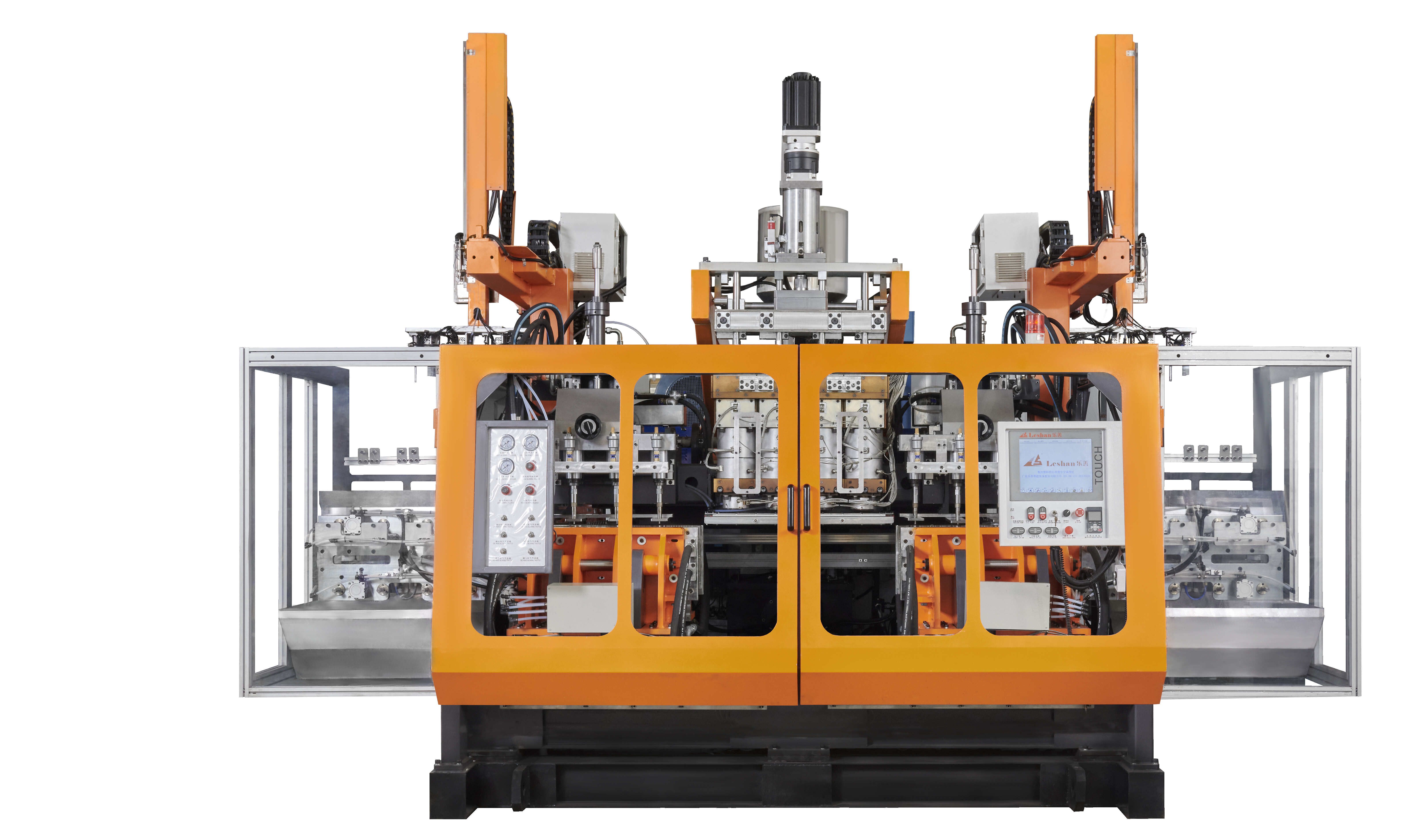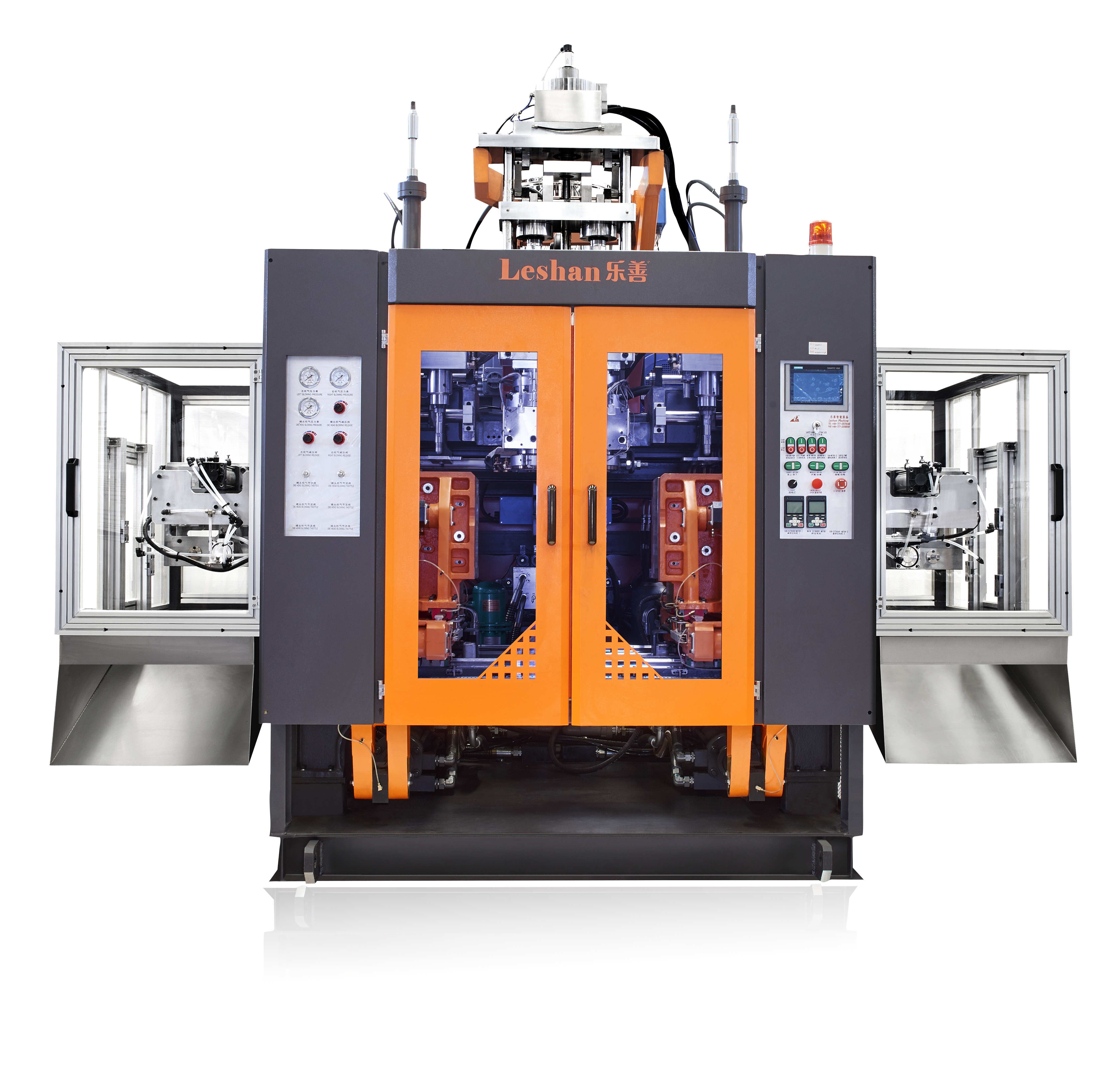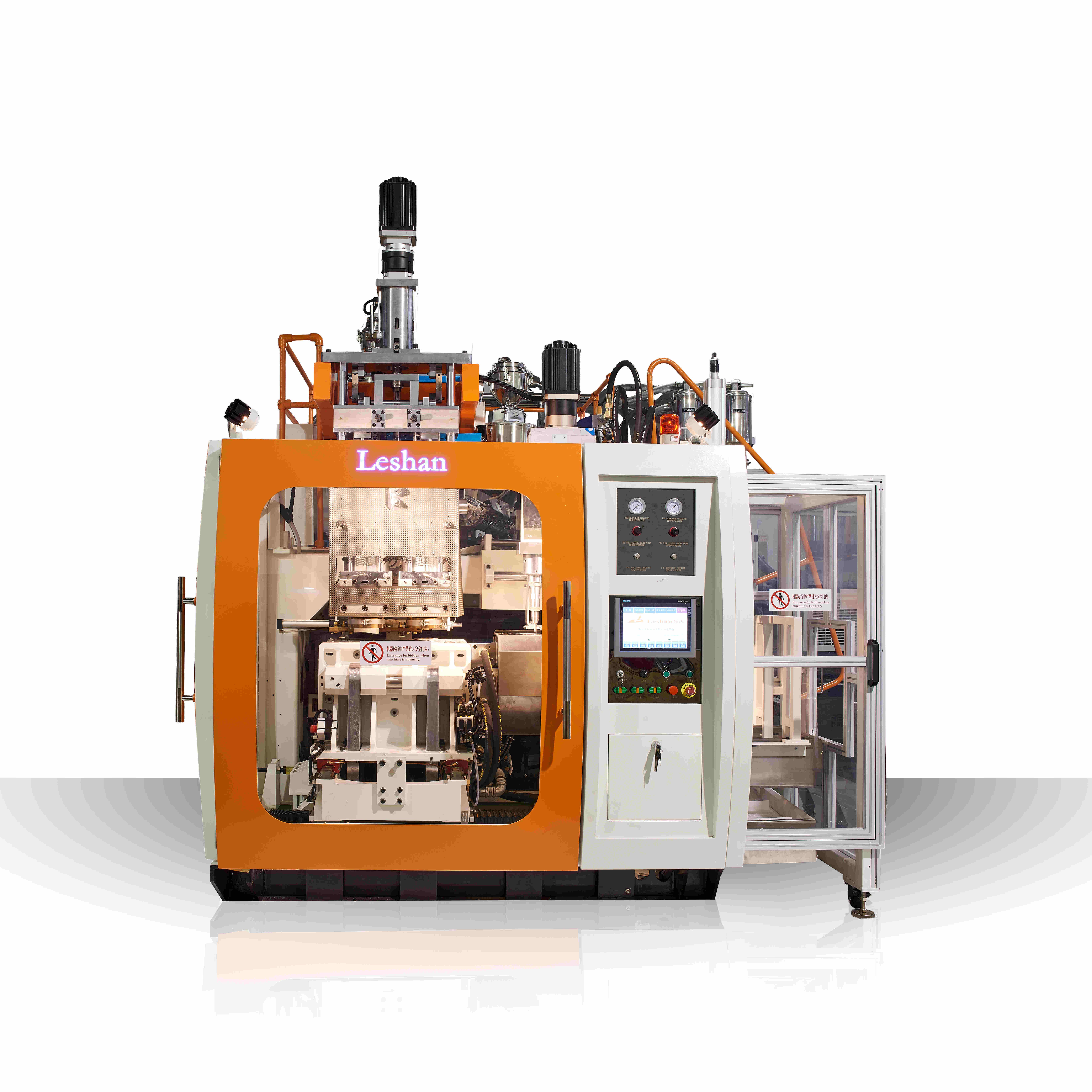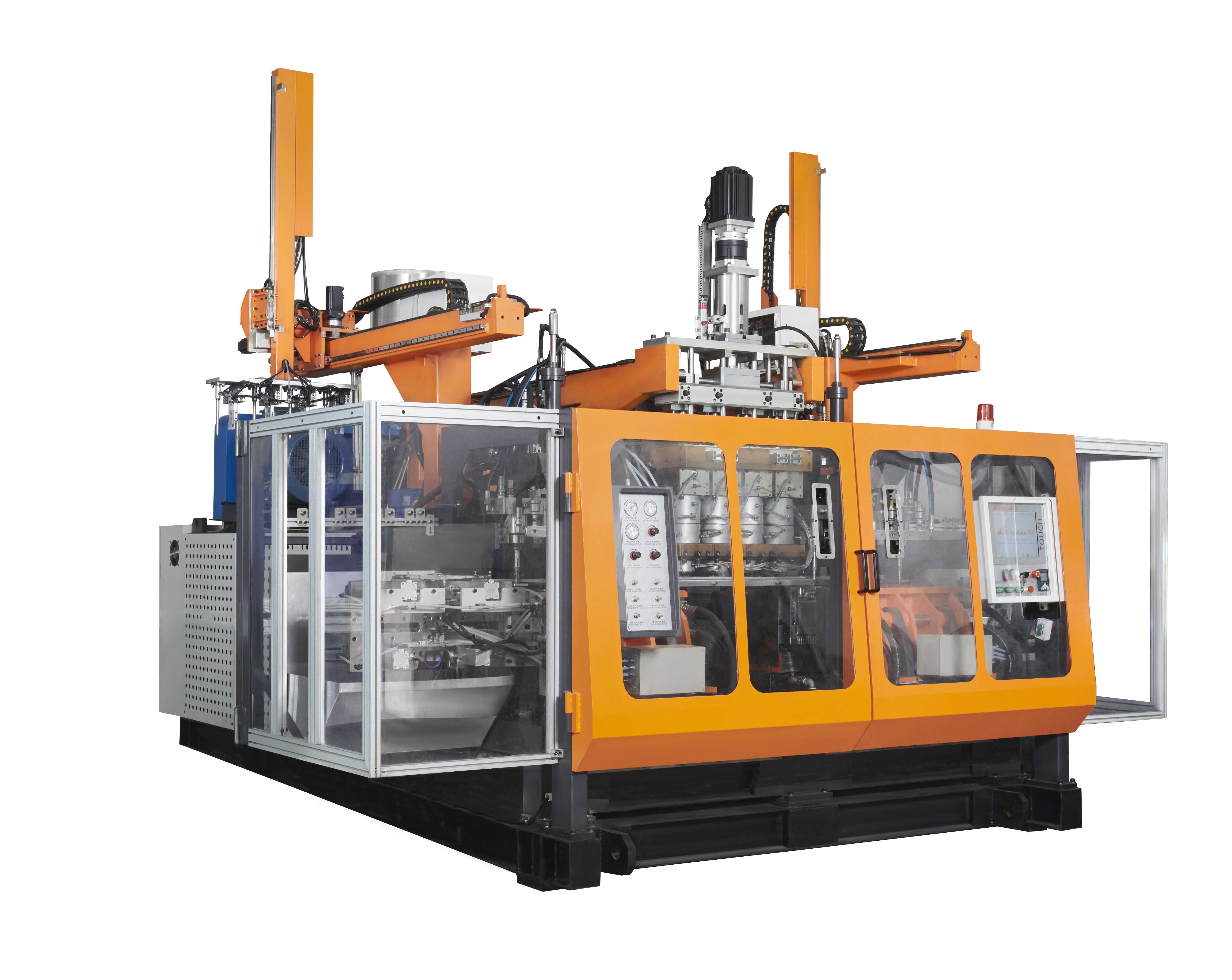
Automatic Blow Mold Machine
Automatic Blow Mold Machine
Leshan Machinery Company's main products include Hydraulic Blow Molding Machine, All-Electric PET Blow Molding Machine and High-precision Mould, athlon series hydraulic machine,Auxiliary machine,multi-layer coextrusion blow molding machine,Food bottle blow molding machine,Extrusion Die Head,Blowing Mould & Injection Mould,Irregular shape product blow molding machine,Daily chemistry bottle blow molding machine,Milk bottle blow molding machine,Engine oil bottle blow molding machine,etc. After more than 20 years' development, we has founded a technical team which was built up by outstanding qualified plastic machinery professionals who combined with rich theoretical knowledge and practical experience.
Currently ,LESHAN has Numerically controlled lathe,Numerical-controlled knee bend machine,Four axis CNC machining-center,Pentahedron gantry machining center,Numerical-controlled cutting machine and other specialized equipment. We are also armed with comprehensive strength such as strong R&D power,production marketing,technical support,etc...
| Parameter | Information |
| Product Name | automatic blow mold machine |
| Place of Origin | China |
| Brand Name | Leshan |
| Condition | New |
| Video outgoing-inspection | Provided |
| Machinery Test Report | Provided |
| Warranty of core components | 1 year |
| Warranty | 1year |
| Port | ShunDe/GuangZhou/ShenZhen China |
| Application | Bottle |
| Core Components | Engine,Gearbox,Pressure vessel,Pump,Motor...etc |
| Color | customized |
| Plastic Processed | PVC,PE,ABS,HDPE,EVA,PP,Polystyrene...etc |
| Certification | CE,ISO9001:2012... |
| PLC Brand | Siemens |
| Packaging Details | Standard exporting machine packing with plastic film |
| Service | Video technical support |
| Automation | Automation |
| Supply Ability | 500 Set/Sets per year |
| Lead time (days) | 70 (To be negotiated) |
Please note: The above table data is for reference only. For specific information, please contact us.

With the development of science and technology, automatic blow mold machine have become intelligent and automated. Through the advanced control system, accurate control of various parameters, such as temperature, pressure, time, etc., can be achieved. Precise control of these parameters can ensure the stable quality of products and reduce losses during the production process.

automatic blow mold machine---FAQs Guide
2.How to adjust the production speed of automatic blow mold machine?
3.How to solve the malfunction of the automatic blow mold machine?
4.What is the after-sales service for automatic blow mold machine?
5.What materials can be used to manufacture automatic blow mold machine?
6.How to design the shaping mold for automatic blow mold machine?
7.What products are typically manufactured using automatic blow mold machine?
8.How to choose the mold head of a automatic blow mold machine?
9.What are the common problems in the production process of automatic blow mold machine?
10.How does the pressure system of a automatic blow mold machine work?
1.What are the advantages of Leshan blow molding machine?
High cost performance, moderate price, more after-sales service coverage, high insurance rate, strong durability of the machine.
2.How to adjust the production speed of automatic blow mold machine?
Our automatic blow mold machine products undergo strict quality control to ensure customer satisfaction.
1. Check the machine settings: The first step in adjusting the production speed of a blow molding machine is to check the machine settings. Make sure that the machine is set to the desired production speed and that all the necessary adjustments have been made.
2. Adjust the air pressure: The air pressure is a crucial factor in the production speed of a blow molding machine. Increasing the air pressure can help to speed up the production process, while decreasing it can slow it down. Adjust the air pressure according to the desired production speed.
3. Change the mold: The size and shape of the mold can also affect the production speed. A larger or more complex mold will take longer to produce, while a smaller and simpler mold will speed up the production process. Consider changing the mold to one that is more suitable for the desired production speed.
4. Increase or decrease the parison size: The parison is the hollow tube of plastic that is formed in the machine and then blown into the mold. Adjusting the size of the parison can also affect the production speed. Increasing the parison size will result in a larger product and slower production, while decreasing the parison size will result in a smaller product and faster production.
5. Adjust the cooling time: The cooling time is the amount of time the product spends in the mold to solidify. Increasing the cooling time will slow down the production speed, while decreasing it will speed it up. Adjust the cooling time according to the desired production speed.
6. Check for any mechanical issues: If the production speed is not adjusting as expected, it is important to check for any mechanical issues with the machine. Make sure that all the components are functioning properly and that there are no obstructions or malfunctions that could be slowing down the production speed.
7. Test and adjust: Once all the necessary adjustments have been made, run a test production to see if the desired speed has been achieved. If not, make further adjustments until the desired production speed is reached.
It is important to note that adjusting the production speed of a blow molding machine may require some trial and error. It is recommended to make small adjustments at a time and test the results before making further adjustments.
3.How to solve the malfunction of the automatic blow mold machine?
As one of the top automatic blow mold machine manufacturers in China, we take this very seriously.
1. Check the power supply: Make sure the machine is properly connected to a stable power source. If there is a power surge or fluctuation, it can cause the machine to malfunction.
2. Inspect the air supply: The blow molding machine requires a steady supply of compressed air to function properly. Check the air compressor and make sure it is providing enough pressure and volume.
3. Check the temperature settings: The temperature of the machine's heating elements must be set correctly for the plastic to melt and form properly. Make sure the temperature settings are appropriate for the type of plastic being used.
4. Clean and lubricate the machine: Over time, dust, debris, and residue can build up on the machine, causing it to malfunction. Clean and lubricate all moving parts to ensure smooth operation.
5. Check for worn or damaged parts: Inspect all parts of the machine for wear and tear. Replace any damaged or worn parts to prevent further malfunctions.
6. Adjust the mold: If the product being produced is not forming correctly, the mold may need to be adjusted. Make sure the mold is properly aligned and tightened.
7. Consult the manual: If the above steps do not solve the problem, consult the machine's manual for troubleshooting tips and solutions specific to your machine.
8. Call a professional: If the problem persists, it may be best to call a professional technician to diagnose and repair the machine. Attempting to fix complex issues without proper knowledge and training can cause further damage.

4.What is the after-sales service for automatic blow mold machine?
We are centered on customers and always pay attention to customers' needs for automatic blow mold machine products.
The after-sales service for blow molding machines typically includes:
1. Technical support: This includes troubleshooting assistance, repair guidance, and advice on machine maintenance and operation.
2. Spare parts supply: The manufacturer or supplier should have a stock of spare parts for the blow molding machine, and be able to provide them quickly when needed.
3. Training: The manufacturer or supplier may offer training programs for operators and maintenance personnel to ensure proper use and maintenance of the machine.
4. Warranty: Most blow molding machines come with a warranty period, during which any defects or malfunctions will be repaired or replaced by the manufacturer or supplier.
5. On-site support: In case of major issues or breakdowns, the manufacturer or supplier may send a technician to the customer's site to provide on-site support and repairs.
6. Upgrades and improvements: The manufacturer or supplier may offer upgrades or improvements to the machine to enhance its performance or add new features.
7. Customer service: A good after-sales service should also include prompt and helpful customer service to address any concerns or questions the customer may have.
Overall, the after-sales service for blow molding machines should ensure that the customer's machine is running smoothly and efficiently, and any issues are resolved quickly to minimize downtime.
5.What materials can be used to manufacture automatic blow mold machine?
We should enjoy a good reputation in the industry, and we can increase the added value of the products of cooperative customers through technological innovation.
1. Steel: The main structural material used in blow molding machines is steel, which provides strength and durability to the machine.
2. Aluminum: Some parts of the machine, such as the extruder, may be made from aluminum due to its lightweight and corrosion-resistant properties.
3. Plastic: The molds used in blow molding machines are typically made from plastic, such as high-density polyethylene (HDPE) or polypropylene (PP).
4. Rubber: Rubber is used for seals and gaskets in the machine to prevent leakage and ensure airtightness.
5. Brass: Brass is used for valves and fittings in the machine due to its corrosion resistance and ability to withstand high temperatures.
6. Copper: Copper is used for electrical components and wiring in the machine due to its good conductivity.
7. Stainless steel: Some parts of the machine, such as the heating elements, may be made from stainless steel due to its resistance to corrosion and high temperatures.
8. Glass: Glass is used for the viewing window on the machine, allowing operators to monitor the production process.
9. Ceramic: Ceramic is used for heating elements and insulation in the machine due to its ability to withstand high temperatures.
10. Composites: Some parts of the machine, such as the control panel, may be made from composite materials, which offer a combination of strength, durability, and lightweight properties.
6.How to design the shaping mold for automatic blow mold machine?
We continuously upgrade our skills and knowledge to adapt to changing automatic blow mold machine market needs.
1. Determine the shape and size of the final product: The first step in designing a shaping mold for blow molding machines is to determine the shape and size of the final product. This will help in determining the overall dimensions and features of the mold.
2. Choose the type of blow molding machine: There are different types of blow molding machines such as extrusion blow molding, injection blow molding, and stretch blow molding. Each type requires a different type of mold design, so it is important to choose the right type of machine for your product.
3. Create a 3D model of the product: Using CAD software, create a 3D model of the product to be molded. This will help in visualizing the final product and identifying any potential design issues.
4. Determine the number of cavities: The number of cavities in the mold will depend on the production volume and the size of the product. More cavities will increase the production rate, but it will also increase the complexity and cost of the mold.
5. Design the core and cavity: The core and cavity are the two main components of the mold. The core is the inner part of the mold that shapes the product, while the cavity is the outer part that gives the product its final shape. The design of these components should be precise and accurate to ensure a high-quality product.
6. Consider draft angles: Draft angles are important in blow molding as they allow the product to be easily removed from the mold. A draft angle of 3-5 degrees is recommended for most products.
7. Add cooling channels: Cooling channels are essential for maintaining the temperature of the mold during the molding process. These channels should be strategically placed to ensure uniform cooling and prevent warping of the product.
8. Include ejection system: An ejection system is used to remove the product from the mold after it has been formed. This can be in the form of pins, air blasts, or mechanical ejection systems.
9. Test and refine the design: Once the initial design is complete, it is important to test it on a prototype mold to identify any design flaws or issues. This will help in refining the design before the final mold is produced.
10. Consider material selection: The material used for the mold should be able to withstand high temperatures and pressures. Common materials used for blow molding molds include aluminum, steel, and beryllium copper.
11. Work with a professional mold maker: It is recommended to work with a professional mold maker who has experience in designing molds for blow molding machines. They can provide valuable insights and ensure that the mold is designed to meet your specific requirements.

7.What products are typically manufactured using automatic blow mold machine?
Our products & services cover a wide range of areas and meet the needs of different fields.
1. Plastic bottles and containers: Blow molding machines are commonly used to produce plastic bottles and containers of various sizes and shapes, such as water bottles, shampoo bottles, and food containers.
2. Automotive components: Many automotive parts, such as fuel tanks, air ducts, and bumpers, are manufactured using blow molding machines.
3. Toys: Blow molding machines are used to produce a wide range of plastic toys, including balls, action figures, and building blocks.
4. Household products: Items such as laundry baskets, storage bins, and trash cans are often made using blow molding machines.
5. Medical equipment: Many medical devices, such as IV bags, syringes, and respiratory masks, are manufactured using blow molding machines.
6. Packaging materials: Blow molding machines are used to produce packaging materials such as plastic bags, pouches, and containers for food and other consumer products.
7. Industrial and agricultural products: Large containers, drums, and tanks used in industrial and agricultural settings are often made using blow molding machines.
8. Sports equipment: Blow molding machines are used to produce a variety of sports equipment, including footballs, soccer balls, and hockey sticks.
9. Furniture: Some types of furniture, such as chairs and tables, are made using blow molding machines to create lightweight and durable plastic components.
10. Construction materials: Blow molding machines are used to produce pipes, tubes, and other construction materials made from plastic.
8.How to choose the mold head of a automatic blow mold machine?
We pay attention to the introduction and training of talents, scientifically regulate the management system, and focus on cultural construction and team cohesion.
1. Determine the type of blow molding machine: The first step in choosing the mold head is to determine the type of blow molding machine you have. There are three main types of blow molding machines: extrusion blow molding, injection blow molding, and stretch blow molding. Each type requires a different type of mold head.
2. Consider the material: The material you will be using for your product is also an important factor in choosing the mold head. Different materials have different properties and require different mold heads. For example, if you are using a high-density polyethylene (HDPE) material, you will need a mold head with a larger opening to accommodate the material's higher melt flow rate.
3. Determine the shape and size of the product: The shape and size of the product you want to produce will also play a role in choosing the mold head. The mold head needs to be able to create the desired shape and size of the product. If you are producing a complex shape, you may need a mold head with multiple cavities or a custom-made mold head.
4. Consider the production volume: The production volume also needs to be taken into account when choosing the mold head. If you are producing a large volume of products, you may need a mold head with multiple cavities to increase production efficiency.
5. Check the compatibility with the machine: It is important to ensure that the mold head you choose is compatible with your blow molding machine. The mold head needs to fit securely and work seamlessly with the machine to produce high-quality products.
6. Look for quality and durability: The mold head is a crucial component of the blow molding process, and it is important to choose one that is of high quality and durable. Look for mold heads made from high-quality materials and with a good track record of performance.
7. Consider the cost: The cost of the mold head is also an important factor to consider. While it is important to choose a high-quality and durable mold head, it is also important to stay within your budget. Compare prices from different suppliers and choose one that offers a good balance of quality and cost.
8. Consult with experts: If you are unsure about which mold head to choose, it is always a good idea to consult with experts in the field. They can provide valuable insights and recommendations based on your specific needs and requirements.
9.What are the common problems in the production process of automatic blow mold machine?
As one of the automatic blow mold machine market leaders, we are known for innovation and reliability.
1. Inconsistent Wall Thickness: This is a common problem in blow molding machines where the thickness of the plastic material is not uniform throughout the product. This can lead to weak spots in the product and affect its overall strength and durability.
2. Flashing: Flashing occurs when excess plastic material leaks out of the mold during the production process. This can result in a rough or uneven surface on the final product, affecting its appearance and functionality.
3. Warping: Warping is a common problem in blow molding machines where the product becomes distorted or deformed during the cooling process. This can be caused by uneven cooling or improper mold design.
4. Air Traps: Air traps occur when air gets trapped inside the mold during the production process. This can result in air bubbles or voids in the final product, affecting its strength and appearance.
5. Poor Surface Finish: Poor surface finish can be caused by a variety of factors, including improper mold design, poor quality plastic material, or inadequate cooling. This can result in a rough or uneven surface on the final product.
6. Leaks: Leaks can occur in blow molding machines due to worn or damaged seals, improper alignment of the mold, or inadequate clamping force. This can result in product defects and production downtime.
7. Contamination: Contamination can occur in the production process when foreign particles or impurities get mixed in with the plastic material. This can result in defects in the final product and affect its quality and functionality.
8. Machine Malfunctions: Like any other machinery, blow molding machines can experience malfunctions such as electrical issues, mechanical failures, or software glitches. These can result in production delays and affect the overall efficiency of the production process.

10.How does the pressure system of a automatic blow mold machine work?
We have a first -class management team, and we pay attention to teamwork to achieve common goals.
The pressure system of a blow molding machine is responsible for creating and maintaining the necessary pressure to inflate the parison (hollow tube of plastic) and shape it into the desired product. This system typically consists of three main components: the air compressor, the accumulator, and the pressure regulator.
1. Air Compressor: The air compressor is the heart of the pressure system. It supplies compressed air to the machine at a high pressure, typically between 100-150 psi. This compressed air is stored in a tank and then fed into the accumulator.
2. Accumulator: The accumulator is a large tank that stores the compressed air from the air compressor. It acts as a buffer, ensuring a steady supply of air to the machine. The accumulator also helps to regulate the pressure and flow of air to the mold.
3. Pressure Regulator: The pressure regulator is responsible for controlling the amount of air that is released from the accumulator into the mold. It is connected to the accumulator and the mold and is set to maintain a specific pressure level during the blow molding process.
The pressure system works in the following steps:
1. The air compressor compresses air and stores it in the accumulator tank.
2. The accumulator tank releases the compressed air into the pressure regulator.
3. The pressure regulator controls the flow of air into the mold, maintaining a specific pressure level.
4. The mold is closed and the parison is placed inside.
5. The mold is then clamped shut and the parison is inflated with the compressed air, taking the shape of the mold.
6. Once the plastic has cooled and solidified, the mold is opened and the finished product is ejected.
7. The pressure system continues to supply compressed air to the mold until the desired product is formed.
The pressure system is crucial in ensuring the quality and consistency of the blow molded products. It must be carefully monitored and maintained to ensure proper pressure levels are maintained throughout the process.
Tags: extrusion pe blowing machine,co extrusion bottle blow molding machine,road barrier blow molding machines
